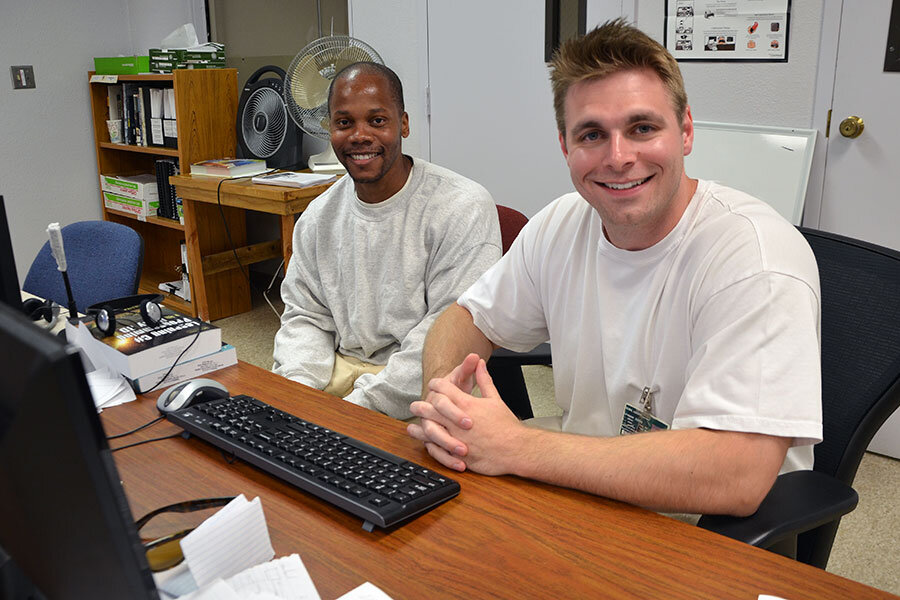Creating a college behind bars
Loading...
| Clallam Bay, Wash.
Up a lonely road lined with signs warning drivers not to pick up hitchhikers, on a hilltop surrounded by forest, the Clallam Bay Corrections Center at the northwest tip of Washington State feels like the ends of the earth.
Yet behind the high walls and concertina wire, inmate Kimonti Carter is spending his 20th year behind bars striving for learning and connection. “We want to build a university in prison,” says Mr. Carter, a soft-spoken man with an earnest tone.
The shortage of higher education opportunities in United States prisons has led inmates like Carter to take the initiative – seeking out textbooks, funds, instructors, and in some cases acting as teachers themselves.
College funding for inmates has been severely limited since 1994, when Congress passed a crime bill that banned the use of federal Pell grants by prisoners. Washington State in 1995 prohibited the use of tax money for college education in prison, allowing only vocational classes offering certificates. In June, the Obama administration announced a pilot project that will enroll 12,000 prisoners in US colleges through the use of Pell grants.
But much more is needed, advocates of prison reform say. Inmates who participate in higher education are much less likely to commit offenses again after they are released, studies show.
Carter became an education activist after years of soul-searching. As a teenager in Tacoma, he carried out a drive-by shooting in 1997, spraying a vehicle with bullets he mistakenly thought belonged to a rival gang member. Instead he killed a university student. Carter was sentenced to life without the possibility of parole.
Over time, Carter got involved in the Black Prisoners’ Caucus and studied the root causes of crime. The need for education was obvious, says Carter, now president of the caucus at Clallam Bay. In 2013, Carter started a prisoner-led education program called Taking Education and Creating History (T.E.A.C.H.), which has obtained grants, private donations, and help from community colleges to teach 400 inmates at Clallam Bay so far.
“It’s been surprising to see how far we’ve come in a short period,” says Carter.
In April, through T.E.A.C.H., Carter and another inmate, Logan Gore, created a 21-month-long computer coding boot camp designed to give fellow prisoners the skills to become junior web developers. The prisoner-taught camp shares a classroom with nearby Peninsula College, which offers a vocational certificate in computers at the prison.
“This is the first program I have that I can hold onto,” says Caesar Garner, a student in the coding class, who will be released next year after serving five years for drug-related crimes. “I have hope with this.”
The Clallam Bay program caught the eye of David Almeida at Microsoft, inspiring him to start a Seattle-area nonprofit, Unloop, to train inmates for technology careers. “I was overwhelmingly impressed by the students’ technical skill,” Mr. Almeida says.
Unloop started its first, year-long coding class in June with 25 students at the Washington Corrections Center for Women (WCCW) in Gig Harbor, Wash. In class one recent morning, inmate Karen Latham tapped on a keyboard designing a poetry website. “My goal is to have my own troubleshooting business,” says Ms. Latham, scheduled for release in 2021.
Washington is expanding the coding program to more prisons. Recruiting teachers to work in prisons is difficult, so Brian Walsh, corrections education manager for the state board of community colleges, wants to facilitate remote teaching. At Clallam Bay, Carter, Garner, and Gore are working on just that – a broadcasting app that will allow teachers to share screens with students. “Breaking down barriers, that’s my goal,” Gore says.
Mikey Farrow, an Unloop teacher at WCCW, says the inmates work harder than most university students he's taught. "Here is a classroom of people who are incredibly motivated," Mr. Farrow says. "Everyone is super invested."







